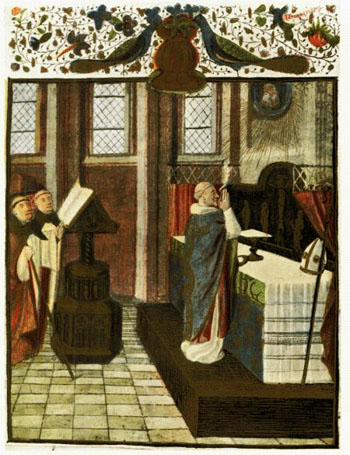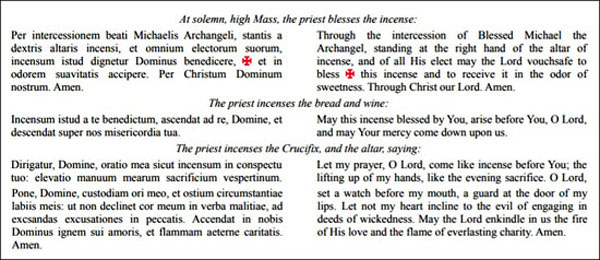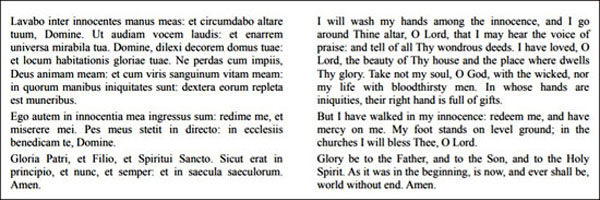About the Church
 |
 |
 |
 |
 |
 |
 |
The Holy Mass - Part IX
Mass of the Faithful:
From the Offertory to the Lavabo
The Mass of the Faithful is the very heart of the Sacrifice of Calvary for in it the Transubstantiation takes place. Fr. Martin von Cochem OFM (1625-1712), a learned German Franciscan theologian, beautifully describes it thus:
 “The Holy Mass is of such surprising excellence that not even one of the highest Angels can praise it properly. St. Francis de Sales says of it in his Introduction to the Devout Life: The Holy Mass is the sum of all spiritual exercises, the mainspring of devotion, the soul of piety, the fire of Divine charity, the abyss of Divine mercy and a precious means whereby God confers upon us his graces!'" (1)
“The Holy Mass is of such surprising excellence that not even one of the highest Angels can praise it properly. St. Francis de Sales says of it in his Introduction to the Devout Life: The Holy Mass is the sum of all spiritual exercises, the mainspring of devotion, the soul of piety, the fire of Divine charity, the abyss of Divine mercy and a precious means whereby God confers upon us his graces!'" (1)
In one sentence Dom Guéranger makes this profound summary: “The Sacrifice of the Mass is the Sacrifice of the Cross itself, and in it we must see Our Lord nailed to the Cross and offering up His Blood for our sins, to His Eternal Father.” (2)
After the last prayer in the Mass of the Catechumens, the priest turns to the people and says “Dominus vobiscum” [The Lord be with you], and the server responds “Et cum spiritu tuo” [And with thy Spirit].
Then, with the words “Oremus”, [Let us pray], the Priest joins his hands and reads the “Offertory,” which is a verse taken from Sacred Scripture and, like the Introit and Gradual, appropriate to the Feast or Season.
The Suscipe
The priest raises the host on the paten and silently recites the “Suscipe, sancte Pater,” which dates as early as the 8th or 9th century. The host that is without spot - immaculatam hostiam - is presented to the Eternal Father to shortly become the Body, Blood, Soul and Divinity of Our Lord Jesus Christ.
Here, Dom Gueranger shows us the value of being actually present and assisting at the Mass, for the priest offers it not just for himself but for all those "those who are here present." (3)
After finishing the first nine words, he lowers his eyes saying “Quam ego indignus famulus" [which I Thy unworthy servant] and completes the “Suscipe.” Then, he makes the Sign of the Cross with the paten and places the host on the corporal. This reminds us once again that the Sacrifice of the Mass is that of Calvary.

The rich symbolism of the mixing of the wine and water
With hands joined the priest walks to the Epistle side of the altar, takes the chalice in his left hand and with his right hand wipes the inside with the purificator. He first pours wine into the chalice, next, he blesses the water and adds a few drops into the chalice while reciting the following:

The priest raises his eyes to Heaven and water and wine are commingled, in imitation of Our Lord Himself Who, according to Tradition, mixed water with the wine when instituting the Holy Eucharist. This comingling typifies two things in a mysterious and symbolic manner:

It is called the “chalice of salvation” because the wine which it contains will become the Precious Blood that poured out of Jesus Christ for our salvation. Thus, the priest asks God to "look beyond" what is actually being offered at this moment, and to accept it so it may be transformed and operate our salvation.
Then, the priest makes the sign of the Cross with the chalice placed in the center of the corporal - again to show that this sacrifice is truly that of the cross - and covers it with the pall. He inclines moderately and prays silently:

This prayer, recalls the words of the Psalmist: “A sacrifice to God is an afflicted spirit: a contrite and humble heart O God thou wilt not despise” (Ps 50: 19). The words are those of the three children in the fiery furnace, as related in the book of Daniel (3: 39-40).
 Next, the Holy Ghost is invoked so that He may deign to operate in changing the bread and wine into the Body and Blood of Our Lord. Just as the Holy Spirit produced Our Lord in the womb of the Blessed Virgin, so does He deign to produce Him again here upon our altar. (5)
Next, the Holy Ghost is invoked so that He may deign to operate in changing the bread and wine into the Body and Blood of Our Lord. Just as the Holy Spirit produced Our Lord in the womb of the Blessed Virgin, so does He deign to produce Him again here upon our altar. (5)
The priest invokes Him with the following few words, at the same time looking upward, raising his hands, folding them reverently and making the sign of the Cross over the oblation:

At a High Mass prior to the Introit, the priest blesses the incense that he puts in the thurible, saying: “Be thou blessed by Him in whose honor thou shall be burned.” He, then, incenses the altar. Prior to the Lavabo at a High Mass, the priest also blesses the incense with the prayer below, afterwards incensing the offerings of the bread and wine, the altar and all who are present. This is a sacramental signifying the graces which the Holy Sacrifice is to obtain for us.

The washing of the hands
At the Lavabo, the washing of the hands, the priest with hands joined goes to the Epistle side. He dips the tip of his thumb and forefinger of both hands into the water, reciting at the same time part of Psalm 25:

About this washing, Dom Gueranger states: "It expresses the need there is for the priest to purify himself yet more and more as he advances in the Holy Sacrifice." Just as Our Lord washed the feet of His Apostles before instituting the Holy Eucharist, so also should the priest purify himself.
This ceremony is also symbolic of the cleanliness and purity of soul and body with which we the faithful should appear before God. At the beginning of the Holy Mass the Confiteor was recited to purify ourselves and to make our heart clean by sincere contrition. The washing of the fingers signifies our petition that Our Lord may wash us yet more from our iniquities and cleanse us from our sins as stated in the Psalm.
Continued


The priest representing Christ offers His Blood and Body for our sins to the Eternal Father
In one sentence Dom Guéranger makes this profound summary: “The Sacrifice of the Mass is the Sacrifice of the Cross itself, and in it we must see Our Lord nailed to the Cross and offering up His Blood for our sins, to His Eternal Father.” (2)
After the last prayer in the Mass of the Catechumens, the priest turns to the people and says “Dominus vobiscum” [The Lord be with you], and the server responds “Et cum spiritu tuo” [And with thy Spirit].
Then, with the words “Oremus”, [Let us pray], the Priest joins his hands and reads the “Offertory,” which is a verse taken from Sacred Scripture and, like the Introit and Gradual, appropriate to the Feast or Season.
The Suscipe
The priest raises the host on the paten and silently recites the “Suscipe, sancte Pater,” which dates as early as the 8th or 9th century. The host that is without spot - immaculatam hostiam - is presented to the Eternal Father to shortly become the Body, Blood, Soul and Divinity of Our Lord Jesus Christ.
Here, Dom Gueranger shows us the value of being actually present and assisting at the Mass, for the priest offers it not just for himself but for all those "those who are here present." (3)
After finishing the first nine words, he lowers his eyes saying “Quam ego indignus famulus" [which I Thy unworthy servant] and completes the “Suscipe.” Then, he makes the Sign of the Cross with the paten and places the host on the corporal. This reminds us once again that the Sacrifice of the Mass is that of Calvary.

The rich symbolism of the mixing of the wine and water
With hands joined the priest walks to the Epistle side of the altar, takes the chalice in his left hand and with his right hand wipes the inside with the purificator. He first pours wine into the chalice, next, he blesses the water and adds a few drops into the chalice while reciting the following:

The priest raises his eyes to Heaven and water and wine are commingled, in imitation of Our Lord Himself Who, according to Tradition, mixed water with the wine when instituting the Holy Eucharist. This comingling typifies two things in a mysterious and symbolic manner:
- First, that His Divine and Human natures are united in a wonderful union: The wine that becomes His Precious Blood signifies His Divine nature, and the water, His Human nature. Thus, together they symbolize the human-divine sacrifice of Christ;
- Second, the drop of water symbolizes our human sacrifices. Water, a liquid without value, is the small part, but that drop of water is also transformed into the Blood of Our Lord. It is a beautiful symbol showing that our sacrifices are accepted by Our Lord to spread the fruits of His Redemption. (4)

It is called the “chalice of salvation” because the wine which it contains will become the Precious Blood that poured out of Jesus Christ for our salvation. Thus, the priest asks God to "look beyond" what is actually being offered at this moment, and to accept it so it may be transformed and operate our salvation.
Then, the priest makes the sign of the Cross with the chalice placed in the center of the corporal - again to show that this sacrifice is truly that of the cross - and covers it with the pall. He inclines moderately and prays silently:

This prayer, recalls the words of the Psalmist: “A sacrifice to God is an afflicted spirit: a contrite and humble heart O God thou wilt not despise” (Ps 50: 19). The words are those of the three children in the fiery furnace, as related in the book of Daniel (3: 39-40).

The Holy Ghost in invoked
The priest invokes Him with the following few words, at the same time looking upward, raising his hands, folding them reverently and making the sign of the Cross over the oblation:

At a High Mass prior to the Introit, the priest blesses the incense that he puts in the thurible, saying: “Be thou blessed by Him in whose honor thou shall be burned.” He, then, incenses the altar. Prior to the Lavabo at a High Mass, the priest also blesses the incense with the prayer below, afterwards incensing the offerings of the bread and wine, the altar and all who are present. This is a sacramental signifying the graces which the Holy Sacrifice is to obtain for us.

The washing of the hands
At the Lavabo, the washing of the hands, the priest with hands joined goes to the Epistle side. He dips the tip of his thumb and forefinger of both hands into the water, reciting at the same time part of Psalm 25:

About this washing, Dom Gueranger states: "It expresses the need there is for the priest to purify himself yet more and more as he advances in the Holy Sacrifice." Just as Our Lord washed the feet of His Apostles before instituting the Holy Eucharist, so also should the priest purify himself.
This ceremony is also symbolic of the cleanliness and purity of soul and body with which we the faithful should appear before God. At the beginning of the Holy Mass the Confiteor was recited to purify ourselves and to make our heart clean by sincere contrition. The washing of the fingers signifies our petition that Our Lord may wash us yet more from our iniquities and cleanse us from our sins as stated in the Psalm.
Continued
- Martin von Cochem, The Incredible Catholic Mass, An Explanation of the Mass, Benzinger Bros., 1896, chap, 2, p. 18.
- Ibid., p. 2.
- Dom Prosper Guéranger, Explanation of the Holy Mass, 1st ed. 1885, rep. Loreto Publications, 2007, p. 65.
- Prof. Plinio Corrêa de Oliveira, The Apostolate of Suffering
- Dom Prosper Guéranger, Explanation of the Holy Mass, p. 65.

Posted September 8, 2017














